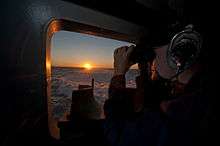Watchstanding

Watchstanding, or watchkeeping, in nautical terms concerns the division of qualified personnel to operate a ship continuously. On a typical sea-faring vessel, be it naval or merchant, personnel keep watch on the bridge and over the running machinery. The generic bridge watchstanders are a lookout and an officer or mate who is responsible for the safe navigation of the ship. Safe navigation means keeping the vessel on course and away from dangers as well as collision avoidance from other shipping. An engineering specialist ensures that running machinery continues to operate within tolerances and depending on the vessel; this can also be accomplished from the bridge. A secondary function of watchkeeping is to respond to emergencies, be it on own ship or involving other ships.
Types of watches
A wide variety of types of watches have developed due to need aboard merchant and naval vessels. This section gives some examples.
Engineering watches
- Naval
Navigational watches
- Merchant
- Naval
Security watches
- Merchant
- Gangway watch
- Special piracy-related watches
- Naval
- Petty Officer of the Watch
- Officer of the Deck (In-port)
- Roving patrol
- Sounding and security
- Pier sentry
- Messenger of the Watch
Communications watches
Other types of watches
- Merchant
- Cargo watch
- Anchor watch
- Naval
Watch systems
Duration
Watch durations will vary between vessels due to a number of reasons and restrictions. The traditional three-watch system is from the days of sail, where the ships company was divided into three and the day divided into six watches of four-hours duration, such that an individual would keep two four-hour watches each day separated by an eight-hour time for sleep or recreation. Examples of other systems include 4 by 6-hour and 7's and 5's when a warship has half its ships company on watch at a time.
Traditional watch system
| Name | Time | Day 1 | Day 2 | Day 3 |
|---|---|---|---|---|
| First watch | 2000-0000 | Team 1 | Team 2 | Team 1 |
| Middle watch | 0000-0400 | Team 2 | Team 1 | Team 2 |
| Morning watch | 0400-0800 | Team 1 | Team 2 | Team 1 |
| Forenoon watch | 0800-1200 | Team 2 | Team 1 | Team 2 |
| Afternoon watch | 1200-1600 | Team 1 | Team 2 | Team 1 |
| First dog watch | 1600-1800 | Team 2 | Team 1 | Team 2 |
| Last dog watch | 1800-2000 | Team 1 | Team 2 | Team 1 |
The watches kept on sailing ships—the square-rigged barques or windjammers of the late 19th century and in the British Royal Navy—consisted of 5 four-hour periods and 2 two-hour periods. Those members of the crew whose work must be done at all times of the day were assigned to one of two divisions: the Starboard or the Port division. These two groups of personnel alternated in working the following watches:
This pattern allowed the two watches, known as the 'port' and 'starboard' watches, to alternate from day to day, so that the port watch had the night watch one night and the starboard watch had it the next night.
A similar system can also be used with a crew divided into three, giving each sailor more time off-duty. Names for the three watches—instead of Port and Starboard—vary between ships; "Foremast", "Mainmast" and "Mizzen" and "Red", "White" and "Blue" are common.
Watches and ship's bells
Ship's bells are a system to indicate the hour by means of bells, used aboard a ship to regulate the sailors' duty watches.
Unlike civil clock bells, the strikes of the bell do not accord to the number of the hour. Instead, there are eight bells, one for each half-hour of a four-hour watch. Bells would be struck every half-hour, and in a pattern of pairs for easier counting, with any odd bells at the end of the sequence.
The traditional system is:[4]
| Number of bells | Middle watch |
Morning watch |
Forenoon watch |
Afternoon watch |
First dog watch |
Last dog watch |
First watch |
| Eight bells | 0:00 | 4:00 | 8:00 | 12:00 | 16:00 | - - - | 20:00 |
| One bell | 0:30 | 4:30 | 8:30 | 12:30 | 16:30 | - - - | 20:30 |
| Two bells | 1:00 | 5:00 | 9:00 | 13:00 | 17:00 | - - - | 21:00 |
| Three bells | 1:30 | 5:30 | 9:30 | 13:30 | 17:30 | - - - | 21:30 |
| Four bells | 2:00 | 6:00 | 10:00 | 14:00 | 18:00 | 18:00 | 22:00 |
| Five bells | 2:30 | 6:30 | 10:30 | 14:30 | - - - | 18:30 | 22:30 |
| Six bells | 3:00 | 7:00 | 11:00 | 15:00 | - - - | 19:00 | 23:00 |
| Seven bells | 3:30 | 7:30 | 11:30 | 15:30 | - - - | 19:30 | 23:30 |
| Eight bells | 4:00 | 8:00 | 12:00 | 16:00 | - - - | 20:00 | 0:00 |
See also
Notes
References
- United States Naval Institute (1996) [1902]. The Bluejackets' Manual (24th ed.). Annapolis, MD: United States Naval Institute. ISBN 978-1591141532.
- James Stavridis; Robert Girrier (2007). Watch Officer's Guide: A Handbook for All Deck Watch Officers (15th ed.). Annapolis, MD: United States Naval Institute. ISBN 1-59114-936-3.